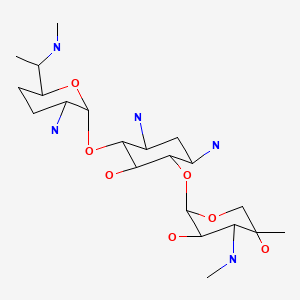Attribution Statement: LactMed is a registered trademark of the U.S. Department of Health and Human Services.
NCBI Bookshelf. A service of the National Library of Medicine, National Institutes of Health.
Drugs and Lactation Database (LactMed®) [Internet]. Bethesda (MD): National Institute of Child Health and Human Development; 2006-.
CASRN: 1403-66-3

Drug Levels and Effects
Summary of Use during Lactation
Gentamicin is poorly excreted into breastmilk. Newborn infants apparently absorb small amounts of gentamicin, but their serum levels with three times daily dosages are far below those attained when treating newborn infections and systemic effects of gentamicin are unlikely. Older infants would be expected to absorb even less gentamicin. Because there is little variability in the milk gentamicin levels during multiple daily dose regimens, timing breastfeeding with respect to the dose is of little or no benefit in reducing infant exposure. Data are not available with single daily dose regimens. Monitor the infant for possible effects on the gastrointestinal flora, such as diarrhea, candidiasis (e.g., thrush, diaper rash) or rarely, blood in the stool indicating possible antibiotic-associated colitis.
Maternal use of an ear drop or eye drop that contains gentamicin presents little or no risk for the nursing infant.[1]
Drug Levels
Maternal Levels. In 5 or 10 women (article unclear) given a single dose of gentamicin 80 mg intramuscularly in the early postpartum period, average milk levels were 157 mcg/L 1 hour after the dose, 156 mcg/L at 3 hours after the dose, 137 mcg/L at 6 hours after the dose and 3 mcg/L at 12 hours after the dose.[2]
After implantation of 90 gentamicin-impregnated beads into the femur of one mother with osteomyelitis, milk levels ranged from 70 to 190 mcg/L at various times over the following 23-day period.[3]
Ten mothers nursing newborn infants were given prophylactic gentamicin 80 mg intramuscularly 3 times a day. On day 4, milk gentamicin levels were as follows: 420 mcg/L 1 hour after the dose; 480 mcg/L 3 hours after the dose; 490 mcg/L at 5 hours after the dose; and, 410 mcg/L 7 hours after the dose.[4]
Infant Levels. In the infants of 5 or 10 women (article unclear) given a single dose of gentamicin 80 mg intramuscularly, none of the breastfed neonates had detectable gentamicin serum levels.[2]
Ten mothers nursing newborn infants were given prophylactic gentamicin 80 mg intramuscularly 3 times a day. One hour after nursing on day 4, gentamicin was undetectable (<270 mcg/L) in the serum of 5 of the infants and averaged 410 mcg/L (range 340 to 490 mcg/L) in the other five infants who nursed one hour after a maternal dose.[4]
Effects in Breastfed Infants
Bloody stools in one 5-day-old infant were possibly caused by concurrent maternal administration of clindamycin and gentamicin.[5]
A 2-month-old infant breastfed since birth. His mother had taken many medications during pregnancy, but she did not recall their identity. She developed mastitis and was treated with amoxicillin-clavulanic acid 1 gram orally every 12 hours and gentamicin 160 mg intramuscularly once daily. The infant was breastfed for 10 minutes starting 15 minutes after the first dose of both drugs. About 20 minutes later, the infant developed a generalized urticaria which disappeared after 30 minutes. A few hours later, the infant breastfed again and the urticaria reappeared after 15 minutes and disappeared after an hour. After switching to formula feeding and no further infant exposure to penicillins, the reaction did not reappear with follow-up to 16 months of age. The adverse reaction was probably caused by the antibiotics in breastmilk. The drug that caused the reaction cannot be determined, but it was most likely the amoxicillin-clavulanic acid.[6]
Effects on Lactation and Breastmilk
Relevant published information was not found as of the revision date.
References
- 1.
- Niebyl JR. Use of antibiotic of ear, nose, and throat disorders in pregnancy and lactation. Am J Otolaryngol. 1992;13:187–92. [PubMed: 1503194]
- 2.
- Ito T. Jpn J Antibiot. 1970;23:298–311. [Absorption and excretion of gentamicin in new-born infants] [PubMed: 5312214]
- 3.
- Boda A. Orvosi Hetilap. 1990;131:2263–5. [Gentamicin concentration in the milk of a mother after treatment by implants of a Septopal chain] [PubMed: 2234920]
- 4.
- Celiloglu M, Celiker S, Guven H, et al. Gentamicin excretion and uptake from breast milk by nursing infants. Obstet Gynecol. 1994;84:263–5. [PubMed: 8041544]
- 5.
- Mann CF. Clindamycin and breast-feeding. Pediatrics 1980;66:1030-1. Letter. PMID: 7454470. [PubMed: 7454470]
- 6.
- Cherif F, El Aidli S, Kastalli S, et al. Drug induced urticaria via breastfeeding. Fundam Clin Pharmacol. 2009;23 Suppl. 1:37–Abstract 203. [CrossRef]
Substance Identification
Substance Name
Gentamicin
CAS Registry Number
1403-66-3
Disclaimer: Information presented in this database is not meant as a substitute for professional judgment. You should consult your healthcare provider for breastfeeding advice related to your particular situation. The U.S. government does not warrant or assume any liability or responsibility for the accuracy or completeness of the information on this Site.
- User and Medical Advice Disclaimer
- Drugs and Lactation Database (LactMed) - Record Format
- LactMed - Database Creation and Peer Review Process
- Fact Sheet. Drugs and Lactation Database (LactMed)
- Drugs and Lactation Database (LactMed) - Glossary
- LactMed Selected References
- Drugs and Lactation Database (LactMed) - About Dietary Supplements
- Breastfeeding Links
- PubChem SubstanceRelated PubChem Substances
- PubMedLinks to PubMed
- Review Tobramycin.[Drugs and Lactation Database (...]Review Tobramycin.. Drugs and Lactation Database (LactMed®). 2006
- Review Kanamycin.[Drugs and Lactation Database (...]Review Kanamycin.. Drugs and Lactation Database (LactMed®). 2006
- Review Amikacin.[Drugs and Lactation Database (...]Review Amikacin.. Drugs and Lactation Database (LactMed®). 2006
- Review Neomycin.[Drugs and Lactation Database (...]Review Neomycin.. Drugs and Lactation Database (LactMed®). 2006
- Review Streptomycin.[Drugs and Lactation Database (...]Review Streptomycin.. Drugs and Lactation Database (LactMed®). 2006
- Gentamicin - Drugs and Lactation Database (LactMed®)Gentamicin - Drugs and Lactation Database (LactMed®)
Your browsing activity is empty.
Activity recording is turned off.
See more...
